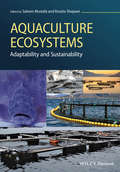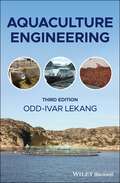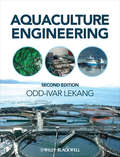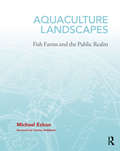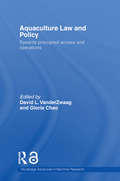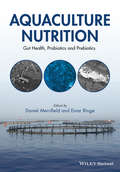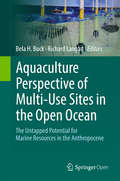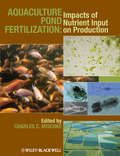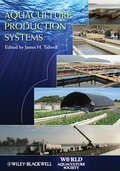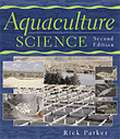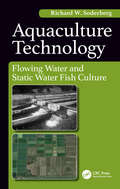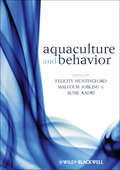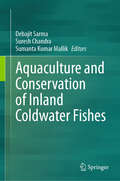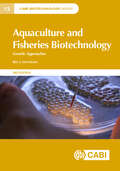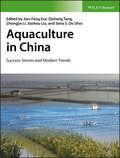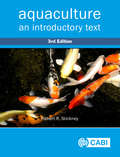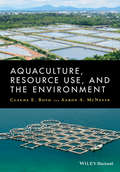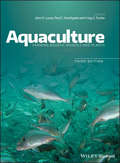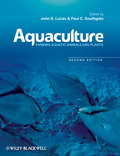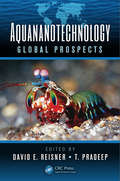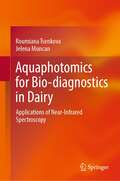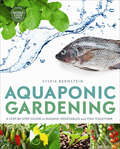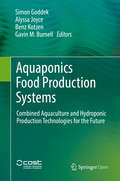- Table View
- List View
Aquaculture Ecosystems
by Saleem Mustafa Rossita ShapawiAquaculture Ecosystems contains a thorough and exciting synthesis of current information on aquaculture practices and substantial discussion of the way forward in transforming the aquaculture industry by improving its sustainability. This important book includes discussion of all the current major issues relating to aquaculture practices in relation to the ecology of their situations, environmental concerns, and details of how sustainability can be improved. Efforts have been made to include chapters that go beyond the stage of debate on old topics, providing conclusions to provide leads for action plans and practices addressing modern challenges such as global climate change. Commencing with a chapter covering concerns and solutions centred around seafood security, the following chapters cover the biology and behavior of aquatic animals and their selection for use in aquaculture systems, integrated multi-trophic aquaculture, nutrient inputs and pollution, biofouling, blue carbon stocks in coastal aquaculture, climate change adaptations and knowledge management in aquaculture. Written by internationally-recognized experts in aquaculture and ecology, and edited by Saleem Mustafa, well known for his work in aquatic sciences, the book provides a great deal of use and interest to all those involved in aquaculture planning and development, environmental sciences and aquatic ecology. All libraries in universities and research establishments where biological sciences and aquaculture are studied and taught should have copies of this vital reference on their shelves.
Aquaculture Engineering
by Odd-Ivar LekangThe revised edition of the comprehensive book that explores the principles and applications of aquaculture engineering Since the publication of the first edition of Aquaculture Engineering there have been many advances in the industry. The revised and thoroughly updated third edition of Aquaculture Engineering covers the principles and applications of all major facets of aquaculture engineering and the newest developments in the field. Written by a noted expert on the topic, the new edition highlights information on new areas of interest including RAS technology and offshore fish farming. Comprehensive in scope, the book examines a range of topics including: water transportation and treatment; feed and feeding systems; fish transportation and grading; cleaning and waste handling; instrumentation and monitoring; removal of particles; aeration and oxygenation; recirculation and water reuse systems; ponds; and the design and construction of aquaculture facilities. This important book: Presents an updated review of the basic principles and applications in aquaculture engineering Includes information on new areas of focus; RAS technology and offshore fish farming Contains a revised edition of the classic resource on aquaculture engineering Continues to offer an authoritative guide written by a leading expert in the field Written for aquaculture scientists and managers, engineers, equipment manufacturers and suppliers, and biological scientists, the third edition of Aquaculture Engineering is the authoritative guide to the topic that has been updated to include the most recent developments in the industry.
Aquaculture Engineering
by Odd-Ivar LekangAs aquaculture continues to grow at a rapid pace, understanding the engineering behind aquatic production facilities is of increasing importance for all those working in the industry. Aquaculture engineering requires knowledge of the many general aspects of engineering such as material technology, building design and construction, mechanical engineering, and environmental engineering. In this comprehensive book now in its second edition, author Odd-Ivar Lekang introduces these principles and demonstrates how such technical knowledge can be applied to aquaculture systems. Review of the first edition: 'Fish farmers and other personnel involved in the aquaculture industry, suppliers to the fish farming business and designers and manufacturers will find this book an invaluable resource. The book will be an important addition to the shelves of all libraries in universities and research institutions where aquaculture, agriculture and environmental sciences are studied and taught.' Aquaculture Europe 'A useful book that, hopefully, will inspire successors that focus more on warm water aquaculture and on large-scale mariculture such as tuna farming.' Cision
Aquaculture Landscapes: Fish Farms and the Public Realm
by Michael EzbanAquaculture Landscapes explores the landscape architecture of farms, reefs, parks, and cities that are designed to entwine the lives of fish and humans. In the twenty-first century, aquaculture’s contribution to the supply of fish for human consumption exceeds that of wild-caught fish for the first time in history. Aquaculture has emerged as the fastest growing food production sector in the world, but aquaculture has agency beyond simply converting fish to food. Aquaculture Landscapes recovers aquaculture as a practice with a deep history of constructing extraordinary landscapes. These landscapes are characterized and enriched by multispecies interdependency, performative ecologies, collaborative practices, and aesthetic experiences between humans and fish. Aquaculture Landscapes presents over thirty contemporary and historical landscapes, spanning six continents, with incisive diagrams and vivid photographs. Within this expansive scope is a focus on urban aquaculture projects by leading designers—including Turenscape, James Corner Field Operations, and SCAPE—that employ mutually beneficial strategies for fish and humans to address urban coastal resiliency, wastewater management, and other contemporary urban challenges. Michael Ezban delivers a compelling account of the coalitions of fish and humans that shape the form, function, and identity of cities, and he offers a forward-thinking theorization of landscape as the preeminent medium for the design of ichthyological urbanism in the Anthropocene. With over two hundred evocative images, including ninety original drawings by the author, Aquaculture Landscapes is a richly illustrated portrayal of aquaculture seen through the disciplinary lens of landscape architecture. As the first book devoted to this topic, Aquaculture Landscapes is an original and essential resource for landscape architects, urbanists, animal geographers, aquaculturists, and all who seek and value multispecies cohabitation of a shared public realm.
Aquaculture Law and Policy: Towards principled access and operations (Routledge Advances in Maritime Research)
by Gloria Chao David L. VanderZwaagThe aquaculture industry is fast expanding around the globe and causing major environmental and social disruptions. The volume is about getting a 'good governance' grip on this important industry. The book highlights the numerous law and policy issues that must be addressed in the search for effective regulation of aquaculture. Those issues include among others: the equitable and fair assignment of property rights; the design of effective dispute resolution mechanisms; clarification of what maritime laws apply to aquaculture; adoption of a proper taxation system for aquaculture; resolution of aboriginal offshore title and rights claims; recognition of international trade law restrictions such as labeling limitations and food safety requirements; and determination of whether genetically modified fish should be allowed and if so under what controls. This book will appeal to a broad range of audiences: undergraduate and postgraduate students, academic researchers, policy makers, NGOs, practicing lawyers and industry representatives.
Aquaculture Nutrition: Gut Health, Probiotics and Prebiotics
by Daniel L. Merrifield Einar RingoManipulation of the microbial gut content of farmed fishes and crustaceans can have a marked effect on their general health, growth, and quality. Expertly covering the science behind the use of prebiotics and probiotics this landmark book explains how the correct manipulation of the gut flora of farmed fishes and crustaceans can have a positive effect on their health, growth rates, feed utilization, and general wellbeing. Aquaculture Nutrition: Gut Health, Probiotics and Prebiotics provides a comprehensive overview of the current knowledge of the gut microbiomes of fish and their importance with respect to host-fish health and performance, providing in-depth, cutting-edge fundamental and applied information. Written by many of the world’s leading authorities and edited by Dr Daniel Merrifield and Professor Einar Ringø, this important book discusses in detail the common mechanisms for modulating microbiomes, particularly at the gut level (e.g. probiotics, prebiotics and synbiotics). The book is a key resource for an understanding of the historical development of these products, their known mechanisms of action and their degree of efficacy as presently demonstrated in the literature. The fundamental material provided on the gut microbiota itself, and more broad aspects of microbe-live feed interactions, provide essential reading for researchers, academics and students in the areas of aquaculture nutrition, fish veterinary science, microbiology, aquaculture, fish biology and fisheries. Those involved in the development and formulation of aquaculture feeds and those with broader roles within the aquaculture industry will find a huge wealth of commercially-important information within the book’s covers. All libraries in universities and research establishments where biological sciences, nutrition and aquaculture are studied and taught, should have copies of this excellent book on their shelves.
Aquaculture Perspective of Multi-Use Sites in the Open Ocean: The Untapped Potential for Marine Resources in the Anthropocene
by Bela H. Buck Richard LanganThis book is open access under a CC BY 4. 0 license. This volume addresses the potential for combining large-scale marine aquaculture of macroalgae, molluscs, crustaceans, and finfish, with offshore structures, primarily those associated with energy production, such as wind turbines and oil-drilling platforms. The volume offers a comprehensive overview and includes chapters on policy, science, engineering, and economic aspects to make this concept a reality. The compilation of chapters authored by internationally recognized researchers across the globe addresses the theoretical and practical aspects of multi-use, and presents case studies of research, development, and demonstration-scale installations in the US and EU.
Aquaculture Pond Fertilization: Impacts of Nutrient Input on Production
by Charles C. MischkePonds are a primary production system to a wide variety of freshwater fish species. Each species have specific and unique nutrient needs and successful pond fertilization is critical to a successful aquaculture enterprise. Aquaculture Pond Fertilization: Impacts of Nutrient Input on Production provides state-of-the-art information for successful fertilization strategies for a broad range of pond-raised species. Aquaculture Pond Fertilization attempts to rectify the seemingly contradictory nutrient recommendations by clearly defining the goals of specific types of aquaculture. Chapters are divided into three sections: The first reviews basic concepts in fertilization applicable to all pond-based production. The second looks at specific nutrient management approaches. The third and final section of chapters looks specifically at key freshwater pond species ranging from tilapia to perch and discusses specific fertilization needs for the successful rearing of these in-demand fish. Looking across species with chapters contributed by leaders in the field Aquaculture Pond Fertilization provides succinct single-volume coverage of an oft-neglected, but vitally important topic in aquaculture production.
Aquaculture Production Systems (World Aquaculture Society Book series)
by James H. TidwellAquaculture is an increasingly diverse industry with an ever-growing number of species cultured and production systems available to professionals. A basic understanding of production systems is vital to the successful practice of aquaculture. Published with the World Aquaculture Society, Aquaculture Production Systems captures the huge diversity of production systems used in the production of shellfish and finfish in one concise volume that allows the reader to better understand how aquaculture depends upon and interacts with its environment. The systems examined range from low input methods to super-intensive systems. Divided into five sections that each focus on a distinct family of systems, Aquaculture Production Systems serves as an excellent text to those just being introduced to aquaculture as well as being a valuable reference to well-established professionals seeking information on production methods.
Aquaculture Science
by Rick ParkerThis comprehensive text introduces students to the aquaculture industry. It covers every aspect of aquaculture, including history, potential, descriptions, management, feeding, marketing, and diseases of aquatic animals and plants. Also addressed are the water requirements and chemistry necessary for successful aquaculture. The book offers detailed information on employment opportunities in the aquaculture industry. The science of aquaculture is stressed throughout to ensure that students understand the fundamental principles. The text includes numerous pedagogical features to ensure students' success.
Aquaculture Technology: Flowing Water and Static Water Fish Culture
by Richard Soderberg W.Key features: Takes a quantitative approach to the science of aquaculture Covers the complete landscape of the scientific basis of fish culture Promotes problem solving and critical thinking Includes sample problems at the end of most chapters Guides the reader through the technical considerations of intensive aquaculture, including fish growth rates, hydraulic characteristics of fish rearing units, oxygen consumption rates in relation to oxygen solubility and fish tolerance of hypoxia, and water reconditioning by reaeration and ammonia filtration. Discusses the environmental effects of aquaculture Includes a chapter on hatchery effluent control to meet receiving water discharge criteria Aquaculture Technology: Flowing Water and Static Water Fish Culture is the first book to provide the skills to raise fish in both a flowing water and a static water aquaculture system with a pragmatic and quantitative approach. Following in the tradition of the author’s highly praised book, Flowing Water Fish Culture, this work will stand out as one that makes the reader understand the theory of each type of aquaculture system; it will teach the user "how to think" rather than "what to think" about these systems. The book presents the scientific basis for the controlled husbandry of fish, whether it be in a stream of water or a standing water pool. Part 1, Flowing Water Fish Culture, is a major revision of the author’s initial book and includes greatly expanded coverage of rearing unit design criteria, fish growth and the use of liquid oxygen, hatchery effluent control, and recirculating systems. Part 2, Static Water Fish Culture, presents the scientific basis of fish culture in standing water systems including nutrient and dissolved gas dynamics, pond ecology, effects of fertilization and supplemental feeding, water quality management and representative static water aquacultures. Aquaculture Technology conveys the science in a manner appropriate for use by university students and teachers and others involved in fish production and aquaculture research and development worldwide. It will enable the reader to adapt to changing technologies, markets, and environmental regulations as they occur.
Aquaculture and Behavior
by Felicity HuntingfordModern aquaculture is faced with a number of challenges, including public concern about environmental impacts and the welfare of farmed fish. A fundamental understanding of fish biology is central to finding ways to meet these challenges and is also essential for maintaining the industry's sustainability. Furthermore, the behaviour of fish under culture situations has long been ignored despite heavy commercial losses that can result from fish stressed and hence disease-prone, due to bad husbandry techniques. This important book summarises the current understanding of the behavioural biology of farmed species and illustrates how this can be applied to improve aquaculture practice. Informative and engaging, Aquaculture & Behavior brings the reader up-to-date with major issues pertaining to aquaculture. Everyone from fish farmers to upper level students will find this book a valuable and practical resource. Libraries in universities and research establishments where animal behavior, aquaculture, veterinary and biological sciences are studied and taught should have copies of this work on their shelves.
Aquaculture and Conservation of Inland Coldwater Fishes
by Suresh Chandra Debajit Sarma Sumanta Kumar MallikThis book provides the latest information on trans-Himalayan Hindu Kush Region (HKR) fisheries including the Indian Himalayan Region (IHR) as well as the historical context of its sustainable development for improving livelihood and nutritional security. The book serves as an important document to provide knowledge and information about the major concerns of environmental and anthropogenic factors that have impacted the population of certain important fishes in the ecosystem and the strategies and policies required for the conservation of these important groups of fishes, viz., Mahseer, snow trout, minor carp, catfishes, etc. The chapters describe the information to the readers on potential cold water and cool water fish species suitable for large-scale farming and propagation addressing the issues of diseases, nutrigenomics, and nanobiotechnology. This book also addresses the prospects and potential of recreational fishing in India and the scope for its improvement to generate more employment and income citing the success stories and primary information from reputed anglers. Finally, the book also elucidates a comprehensive yet representative description of many challenges associated with inland coldwater- cool water fisheries and aquaculture in HKR, IHR, and its way forward.
Aquaculture and Fisheries Biotechnology: Genetic Approaches (CABI Biotechnology Series)
by Rex DunhamThe genetic improvement of fish for aquaculture and related fisheries has seen huge advances over recent years. Building upon the previous two editions of Aquaculture and Fisheries Biotechnology: Genetic Approaches, this 3rd edition offers a presentation of traditional selective breeding, modern genetic biotechnology, genomics, gene transfer and gene editing, and the latest developments in genetic biotechnology such as epigenetics, xenogenesis and genome-wide association study coupled with commercial application, the impact of government regulation and expectations for the future. It provides a firm grounding in relevant aspects of classical genetics, before focusing on particular aspects such as sex reversal and breeding as applied in aquaculture and fisheries. It also explores how more recent molecular genetics, genomics and biotechnology techniques can be used and combined in improvement programmes for fish and aquaculture species. A glossary explains the latest terminology used in biotechnology and genetics. This book will be useful for research scientists and students in marine biotechnology, aquaculture biotechnology, and fish genetics and breeding.
Aquaculture in China: Success Stories and Modern Trends
by Sena S. De Silva Jian-Fang Gui Qisheng Tang Zhongjie Li Jiashou LiuFish have been a major component of our diet and it has been suggested that fish/seafood consumption contributed to the development of the human brain, and this together with the acquisition of bipedalism, perhaps made us what we are. In the modern context global fish consumption is increasing. However, unlike our other staples, until a few years back the greater proportion of our fish supplies were of a hunted origin. This scenario is changing and a greater proportion of fish we consume now is of farmed origin. Aquaculture, the farming of waters, is thought to have originated in China, many millennia ago. Nevertheless, it transformed into a major food sector only since the second half of the last century, and continues to forge ahead, primarily in the developing world. China leads the global aquaculture production in volume, in the number of species that are farmed, and have contributed immensely to transforming the practices from an art to a science. This book attempts to capture some of the key elements and practices that have contributed to the success of Chinese aquaculture. The book entails contributions from over 100 leading experts in China, and provides insights into some aquaculture practices that are little known to the rest of the world. This book will be essential reading for aquaculturists, practitioners, researchers and students, and planners and developers.
Aquaculture, 3rd Edition
by Robert R. StickneyProviding a broad and readable overview of the subject, this updated third edition of Aquaculture: An Introductory Text covers issues associated with sustainable aquaculture development, culture systems, hatchery methods, nutrition and feeding of aquaculture species, reproductive strategies, harvesting and many other topics. While its main focus is on the culture of fish, molluscs and crustaceans for food, the book also covers other forms of aquaculture, such as the production of seaweeds, recreational fish and ornamental species, and live foods such as algae and rotifers that are used to feed larval shrimp and marine fish. Thoroughly updated and revised, the third edition of this essential textbook now includes: - Increased coverage of species under culture - Increased scope to cover species for enhancement, recreational fishing, commercial fishing and aquaria - Newly developed culture systems - Information on predictive impacts of climate change - Updated aquaculture production statistics Aquaculture remains one of the most rapidly growing agricultural disciplines and this book remains an essential resource for all students of aquaculture and related disciplines.
Aquaculture, Resource Use, and the Environment
by Aaron Mcnevin Claude BoydAquaculture, Resource Use, and the Environment places aquaculture within the larger context of global population growth, increased demand for sustainable, reliable sources of food, and the responsible use of natural resources. Aquaculture production has grown rapidly in recent decades as over-exploitation and environmental degradation have drastically reduced wild fish stocks. As fish production has increased, questions have persisted about the environmental sustainability of current aquaculture practices. Aquaculture, Resource Use, and the Environment is a timely synthesis and analysis of critical issues facing the continued growth and acceptance of aquaculture practices and products. Chapters look at the past, present, and future demands for food, tackle key issues ranging from land and water use to mitigation of negative environmental impacts of fish production, and critically review aquaculture production systems. Providing broad coverage of issues that are essential to the continued development of aquaculture production, Aquaculture, Resource Use, and the Environment will be vital resource for anyone involved in the field of aquaculture.
Aquaculture: An Introductory Text
by Robert R Stickney Delbert Gatlin IIIProviding a broad and readable overview of the subject, this updated fourth edition of Aquaculture: An Introductory Text covers issues associated with sustainable aquaculture development, culture systems, hatchery methods, nutrition and feeding of aquaculture species, reproductive strategies, harvesting, and many other topics. While its main focus is on the culture of fish, molluscs and crustaceans for food, the book also covers other forms of aquaculture, such as the production of seaweeds, recreational fish and ornamental species, as well as live foods, such as algae and rotifers that are used to feed larval shrimp and marine fish. Thoroughly updated and revised, this essential textbook now includes: - Increased coverage of open-ocean cage culture and sea lice issues with salmon culture; - Coverage of the significant progress made in nutrition, including the move away from fishmeal as protein and fish oil as lipids in feed; - Information on biofloc technology uses, predictive impacts of climate change, probiotics, and the impact of COVID-19 on the aquaculture community; - Updated aquaculture production statistics and lists of approved anaesthetics. Aquaculture remains one of the most rapidly growing agricultural disciplines, and this book remains an essential resource for all students of aquaculture and related disciplines
Aquaculture: An Introductory Text
by Robert R StickneyProviding a broad and readable overview of the subject, this updated third edition of Aquaculture: An Introductory Text covers issues associated with sustainable aquaculture development, culture systems, hatchery methods, nutrition and feeding of aquaculture species, reproductive strategies, harvesting and many other topics. While its main focus is on the culture of fish, molluscs and crustaceans for food, the book also covers other forms of aquaculture, such as the production of seaweeds, recreational fish and ornamental species, and live foods such as algae and rotifers that are used to feed larval shrimp and marine fish. Thoroughly updated and revised, the third edition of this essential textbook now includes: - Increased coverage of species under culture - Increased scope to cover species for enhancement, recreational fishing, commercial fishing and aquaria - Newly developed culture systems - Information on predictive impacts of climate change - Updated aquaculture production statistics Aquaculture remains one of the most rapidly growing agricultural disciplines and this book remains an essential resource for all students of aquaculture and related disciplines.
Aquaculture: Farming Aquatic Animals and Plants
by John S. Lucas Paul C. Southgate Craig S. TuckerA clear illustration of the important role of aquaculture in supporting food security, livelihoods, and economic development around the world This new edition of Aquaculture: Farming Aquatic Animals and Plants covers important aspects of the culture of fish, shellfish, and algae in freshwater and marine environments. Subject areas covered include principles of aquaculture, water quality, environmental impacts of aquaculture, desert aquaculture, reproduction, life cycles and growth, genetics and stock improvement, nutrition and feed production, diseases, vaccination, post-harvest technology, economics and marketing, and future developments of aquaculture. Separate chapters also cover the culture of algae, carps, salmonids, tilapias, catfish, marine and brackish fishes, soft-shelled turtles, barramundi, marine shrimp, mitten crabs, and other decapod crustaceans, bivalves, gastropods, and ornamental species. This edition also provides greater coverage of aquaculture in China, reflecting the country’s importance in the global scene. Providing core scientific and commercially useful information, and written by 35 eminent international authors, this expanded and fully updated Third Edition of Aquaculture is essential reading for all students and professionals studying and working in aquaculture. Fish farmers, hatchery managers, and those in aquaculture support and supply industries, such as feed manufacturing, will find an abundance of commercially useful information within this important and now established book. Describes the multitude of developments that have occurred within the aquaculture field over the last 15 years Includes a major revision of production statistics and trends, discussion of technical developments, and revised and extended coverage provided by broader international authorship Brings together 35 internationally recognized contributors, including a number of new contributors Aquaculture: Farming Aquatic Animals and Plants, Third Edition is a recommended text for students of the subject and a concise reference for those working in or entering into the industry.
Aquaculture: Farming Aquatic Animals and Plants
by John S. Lucas Paul C. SouthgateThe output from world aquaculture, a multi-billion dollar global industry, continues to rise at a very rapid rate and it is now acknowledged that it will take over from fisheries to become the main source of animal and plant products from aquatic environments in the future. Since the first edition of this excellent and successful book was published, the aquaculture industry has continued to expand at a massive rate globally and has seen huge advances across its many and diverse facets. This new edition of Aquaculture: Farming Aquatic Animals and Plants covers all major aspects of the culture of fish, shellfish and algae in freshwater and marine environments. Subject areas covered include principles, water quality, environmental impacts of aquaculture, desert aquaculture, reproduction, life cycles and growth, genetics and stock improvement, nutrition and feed production, diseases, vaccination, post-harvest technology, economics and marketing, and future developments of aquaculture. Separate chapters also cover the culture of algae, carps, salmonids, tilapias, channel catfish, marine and brackish fishes, soft-shelled turtles, marine shrimp, mitten crabs and other decapod crustaceans, bivalves, gastropods, and ornamentals. There is greater coverage of aquaculture in China in this new edition, reflecting China's importance in the world scene. For many, Aquaculture: Farming Aquatic Animals and Plants is now the book of choice, as a recommended text for students and as a concise reference for those working or entering into the industry. Providing core scientific and commercially useful information, and written by around 30 internationally-known and respected authors, this expanded and fully updated new edition of Aquaculture is a book that is essential reading for all students and professionals studying and working in aquaculture. Fish farmers, hatchery managers and all those supplying the aquaculture industry, including personnel within equipment and feed manufacturing companies, will find a great deal of commercially useful information within this important and now established book. Reviews of the First Edition "This exciting, new and comprehensive book covers all major aspects of the aquaculture of fish, shellfish and algae in freshwater and marine environments including nutrition and feed production." —International Aquafeed "Do we really need yet another book about aquaculture? As far as this 502-page work goes, the answer is a resounding 'yes'. This book will definitely find a place in university libraries, in the offices of policy-makers and with economists looking for production and marketing figures. Fish farmers can benefit greatly from the thematic chapters, as well as from those pertaining to the specific plant or animal they are keeping or intending to farm. Also, they may explore new species, using the wealth of information supplied." —African Journal of Aquatic Science "Anyone studying the subject or working in any way interested in aquaculture would be well advised to acquire and study this wide-ranging book. One of the real 'bibles' on the aquaculture industry." —Fishing Boat World and also Ausmarine
Aquananotechnology: Global Prospects
by T. Pradeep David E. ReisnerThe world's fresh water supplies are dwindling rapidly-even wastewater is now considered an asset. By 2025, most of the world's population will be facing serious water stresses and shortages. Aquananotechnology: Global Prospects breaks new ground with its informative and innovative introduction of the application of nanotechnology to the remediatio
Aquaphotomics for Bio-diagnostics in Dairy: Applications of Near-Infrared Spectroscopy
by Roumiana Tsenkova Jelena MuncanThis book is the result of more than 20 years of experience in working with near-infrared spectroscopy for raw milk analysis. The totality of this work presents extensive possibilities for milk spectral measurements that can be carried out in dairy. Moving beyond the standard milk components such as fat, protein, or lactose, this book presents near-infrared spectroscopy as a method that can also be used in disease diagnostics. The measurements and experimental results presented here are all based on the utilization of usually neglected near-infrared regions—regions with strong absorbance of water. The author has found the water – light interaction discussed to be an immensely rich source of information, not only on milk composition but also on the physiological status of the animals involved. A special section of the book is dedicated to exploration of potential interfering factors that may influence the analysis and contribute to the robustness of the models. The research described in this book served as a basis for the development of the novel discipline aquaphotomics and is of interest to anyone working in this field.
Aquaponic Gardening: A Step-by-Step Guide to Raising Vegetables and Fish Together (Mother Earth News Books for Wiser Living)
by Sylvia Bernstein&“I have always wanted to figure out how to do sustainable aquaculture in the context of my home garden. Finally I&’ve got the book to help me do it.&” —Paul Greenberg, New York Times–bestselling author, Four Fish: The Future of the Last Wild Food Aquaponics is a revolutionary system for growing plants by fertilizing them with the waste water from fish in a sustainable closed system. A combination of the best of aquaculture and hydroponics, aquaponic gardening is an amazingly productive way to grow organic vegetables, greens, herbs and fruits, while providing the added benefits of fresh fish as a safe, healthy source of protein. On a larger scale, it is a key solution to mitigating food insecurity, climate change, groundwater pollution and the impacts of overfishing on our oceans.Aquaponic Gardening is the definitive do-it-yourself home manual, focused on giving you all the tools you need to create your own aquaponic system and enjoy healthy, safe, fresh and delicious food all year round. Starting with an overview of the theory, benefits and potential of aquaponics, the book goes on to explain: System location considerations and hardware components The living elements—fish, plants, bacteria, and worms Putting it all together—starting and maintaining a healthy system. Aquaponics systems are completely organic. They are four to six times more productive and use 90 percent less water than conventional gardens. Other advantages include no weeds, fewer pests, and no watering, fertilizing, bending, digging, or heavy lifting—in fact, there really is no down side! Anyone interested in taking the next step towards self-sufficiency will be fascinated by this practical, accessible and well-illustrated guide. &“An excellent primer for anyone considering home-scale aquaculture.&” —Peter Bane, publisher, Permaculture Activist and author, The Permaculture Handbook
Aquaponics Food Production Systems: Combined Aquaculture and Hydroponic Production Technologies for the Future
by Simon Goddek Alyssa Joyce Benz Kotzen Gavin M. BurnellThis open access book, written by world experts in aquaponics and related technologies, provides the authoritative and comprehensive overview of the key aquaculture and hydroponic and other integrated systems, socio-economic and environmental aspects. Aquaponic systems, which combine aquaculture and vegetable food production offer alternative technology solutions for a world that is increasingly under stress through population growth, urbanisation, water shortages, land and soil degradation, environmental pollution, world hunger and climate change.
